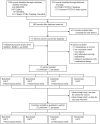The Efficacy and Safety of Janus Kinase Inhibitors for Patients With COVID-19: A Living Systematic Review and Meta-Analysis
- PMID: 35155477
- PMCID: PMC8828941
- DOI: 10.3389/fmed.2021.800492
The Efficacy and Safety of Janus Kinase Inhibitors for Patients With COVID-19: A Living Systematic Review and Meta-Analysis
Abstract
Background: Cytokine storm observed in patients with severe Coronavirus Disease 2019 (COVID-19) contributes to poor clinical outcomes and increased mortality. Janus kinases (JAKs) are important mediators in the cytokine storm. Therefore, we conduct a living systematic review and meta-analysis of the literature investigating efficacy and safety of JAK inhibitors for patients with COVID-19.
Methods: Databases were searched up to December 1, 2021 for interventional and observational studies comparing JAK inhibitor treatment with concurrent control in patients with COVID-19. Efficacy and safety outcomes were evaluated by pooled risk ratio (RR).
Results: Of 3,170 records retrieved, 15 studies were eligible and 13 were evaluated in the meta-analysis (n = 3,977). Based on data from three randomized controlled trials (RCTs), baricitinib treatment significantly decreased mortality by day 28 in hospitalized patients with COVID-19 (RR = 0.64, 95% CI 0.51-0.80) without increasing the incidence of adverse outcomes. In subgroup analysis, patients who required supplemental oxygen (RR = 0.62, 95% CI 0.41-0.95) or high-flow oxygen/non-invasive ventilation (RR = 0.59, 95% CI 0.42-0.85) at baseline benefited most. Pooled analysis of all eligible studies for JAK inhibitors (baricitinib, ruxolitinib, tofacitinib, and nezulcitinib) demonstrated a significant decrease in mortality (RR = 0.62, 95% CI 0.49-0.78) with no increase in the risk of adverse events.
Conclusion: Baricitinib probably decreases mortality in hospitalized adult patients with COVID-19, especially for patients who required supplemental oxygen or high-flow oxygen/non-invasive ventilation at baseline. The efficacy and safety of other JAK inhibitors, such as ruxolitinib, tofacitinib, and nezulcitinib, await more evidence.
Systematic review registration: https://www.crd.york.ac.uk/prospero/display_record.php?ID=CRD42021261414, identifier: CRD42021261414.
Keywords: COVID-19; Janus kinase inhibitors; SARS-CoV-2; baricitinib; meta-analysis; systematic review.
Copyright © 2022 Zhang, Shang, Fan, Gu, Xu, Wang, Huang and Cao.
Conflict of interest statement
The authors declare that the research was conducted in the absence of any commercial or financial relationships that could be construed as a potential conflict of interest.
Figures




Comment in
-
Intentional treatment with tofacitinib in a patient with severe refractory ulcerative colitis and concomitant Sars-CoV-2 infection.Dig Liver Dis. 2022 Nov;54(11):1598-1599. doi: 10.1016/j.dld.2022.08.038. Epub 2022 Sep 6. Dig Liver Dis. 2022. PMID: 36137935 Free PMC article. No abstract available.
Similar articles
-
Janus kinases inhibitors for coronavirus disease-2019: A pairwise and Bayesian network meta-analysis.Front Med (Lausanne). 2022 Nov 23;9:973688. doi: 10.3389/fmed.2022.973688. eCollection 2022. Front Med (Lausanne). 2022. PMID: 36507538 Free PMC article.
-
Clinical efficacy and safety of Janus kinase inhibitors for COVID-19: A systematic review and meta-analysis of randomized controlled trials.Int Immunopharmacol. 2021 Oct;99:108027. doi: 10.1016/j.intimp.2021.108027. Epub 2021 Jul 31. Int Immunopharmacol. 2021. PMID: 34343937 Free PMC article.
-
Janus kinase inhibitors and major COVID-19 outcomes: time to forget the two faces of Janus! A meta-analysis of randomized controlled trials.Clin Rheumatol. 2021 Nov;40(11):4671-4674. doi: 10.1007/s10067-021-05884-4. Epub 2021 Aug 24. Clin Rheumatol. 2021. PMID: 34431004 Free PMC article.
-
The efficacy and safety of JAK inhibitors for alopecia areata: A systematic review and meta-analysis of prospective studies.Front Pharmacol. 2022 Aug 24;13:950450. doi: 10.3389/fphar.2022.950450. eCollection 2022. Front Pharmacol. 2022. PMID: 36091777 Free PMC article.
-
Cardiovascular safety of Janus kinase inhibitors in patients with rheumatoid arthritis: systematic review and network meta-analysis.Front Pharmacol. 2023 Aug 8;14:1237234. doi: 10.3389/fphar.2023.1237234. eCollection 2023. Front Pharmacol. 2023. PMID: 37614310 Free PMC article.
Cited by
-
The Potential of Glucosinolates and Their Hydrolysis Products as Inhibitors of Cytokine Storms.Molecules. 2024 Oct 11;29(20):4826. doi: 10.3390/molecules29204826. Molecules. 2024. PMID: 39459194 Free PMC article. Review.
-
FRAGILE-COLCOVID19: A Clinical Trial Based on Early Administration of an Oral Combination of Colchicine and Prednisone in Elderly Patients with COVID-19 in Geriatric Facilities.Clin Drug Investig. 2022 Nov;42(11):949-964. doi: 10.1007/s40261-022-01201-2. Epub 2022 Sep 29. Clin Drug Investig. 2022. PMID: 36173596 Free PMC article. Clinical Trial.
-
JAK Inhibitors in Cytokine Storm Syndromes.Adv Exp Med Biol. 2024;1448:583-600. doi: 10.1007/978-3-031-59815-9_39. Adv Exp Med Biol. 2024. PMID: 39117841 Review.
-
Tofacitinib in Patients Hospitalized With Moderate and Severe COVID-19: Not Just Another Kinase Inhibitor.Cureus. 2024 Jan 22;16(1):e52725. doi: 10.7759/cureus.52725. eCollection 2024 Jan. Cureus. 2024. PMID: 38384612 Free PMC article.
-
Double-edged sword of JAK/STAT signaling pathway in viral infections: novel insights into virotherapy.Cell Commun Signal. 2023 Oct 2;21(1):272. doi: 10.1186/s12964-023-01240-y. Cell Commun Signal. 2023. PMID: 37784164 Free PMC article. Review.
References
Publication types
LinkOut - more resources
Full Text Sources
Miscellaneous

